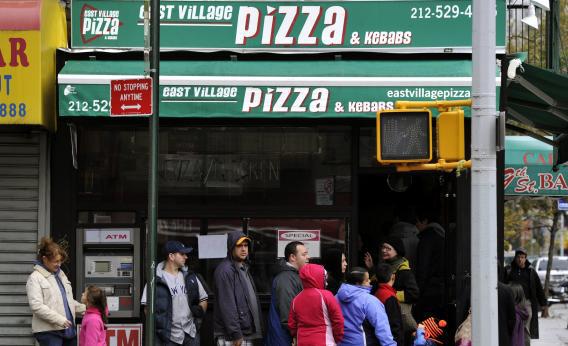I love pizza and I love Kenji Alt’s writing at Serious Eats, but his ongoing efforts to devise a perfect cook-pizza-at-home scheme puzzle me. The ideal way to make pizza at home is to … not make pizza at home. Yes, you can get a kettle grill and then add the KettlePizza attachment and use it in combination with a pizza steel for what’s apparently the best at-home pizza solution yet. But why bother? Pizza is just a great instance of a complicated modern economy in action, and the best way to enjoy pizza is to purchase it from a specialized pizza fabrication facility.
The issue is that while great pizza is fairly simple to make, cooking it properly requires an expensive piece of capital equipment. Your oven can’t get nearly hot enough to cook a pizza correctly. To do it, you need a pizza oven. To install a good pizza oven in your house would be a waste of both money and space. It just doesn’t make sense to construct one unless it’s going to cook a lot of pizza. And while pizza is delicious, for the sake of your health you should probably try to avoid subsisting on an all-pizza diet. The superior strategy is to let someone else install a pizza oven in his commercial establishment. Then you show up occasionally, and in exchange for money he’ll give you pizza. Then with all the money that his pizza oven helps him collect, he and the members of his staff can purchase adequate nonpizza sustenance to stay alive and well. It’s a triumph of the division of labor and good old fashioned commerce. For the roughly $200 that Alt wants you to spend on equipment to turn your grill into an ersatz pizza oven, you could just buy 16 margherita pizzas at my favorite D.C. pizza establishment. And, again, for reasonable adults the financial cost of purchasing excellent pizza at a restaurant is not the operative factor in limiting pizza consumption. In the scheme of things, pizza is pretty cheap.
Now of course, to each his own. If what you want is some home-cooked pizza, I’m sure this is a great way to do it. But it’s a bit nuts. And excessive focus on the issue obscures one of the great economic triumphs of our time—the enormous increase in the availability of quality pizza all around America.
My paternal grandfather was an old-time New York pizza snob, and he’d be amazed by the quality of the pizza you can buy these days in a California airport. There used to be a lot of myths stalking the land about the intimate connection between great pizza and New York water. But it turns out that to make great pizza all you really need are relatively inexpensive ingredients, a piece of capital equipment, and some eminently teachable skills. The key thing holding pizza back was really the customer base. Why invest in the capital equipment and the worker training if the customers won’t appreciate it? But once appreciation for good pizza started spreading beyond the confines of the Philly-to-Providence Pizza Belt, it started feeding on itself. The more good pizza that’s out there, the more people there are who know what good pizza tastes like and want it. So the volume of pizza-relevant human and physical capital grows, and we increasingly find ourselves living in a land of pizza abundance. Why turn our back on all this to wrangle with home-cooked pizza?
